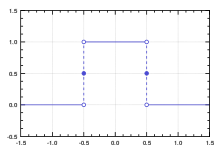The rectangular function , also called rect function, is a discontinuous mathematical function with the following definition:
rect
(
t
)
=
⊓
(
t
)
=
{
0
if
|
t
|
>
1
2
1
2
if
|
t
|
=
1
2
1
if
|
t
|
<
1
2
.
{\ displaystyle \ operatorname {rect} (t) = \ sqcap (t) = {\ begin {cases} 0 & {\ text {if}} | t |> {\ frac {1} {2}} \\ [3pt ] {\ frac {1} {2}} & {\ mbox {if}} | t | = {\ frac {1} {2}} \\ [3pt] 1 & {\ text {if}} | t | < {\ frac {1} {2}}. \ end {cases}}}
Alternative definitions, which are particularly common in the field of signal processing , define the rectangular function in simplified form as:
r
e
c
t
d
(
t
)
=
{
1
if
|
t
|
≤
1
2
0
if
|
t
|
>
1
2
.
{\ displaystyle \ operatorname {rect_ {d}} (t) = {\ begin {cases} 1 & {\ text {if}} | t | \ leq {\ frac {1} {2}} \\ [3pt] 0 & {\ text {if}} | t |> {\ frac {1} {2}}. \ end {cases}}}
General The rectangle function can also be expressed using the Heaviside function as:
Θ
(
x
)
{\ displaystyle \ Theta (x)}
rect
(
t
)
=
Θ
(
t
+
1
2
)
⋅
Θ
(
1
2
-
t
)
=
Θ
(
t
+
1
2
)
-
Θ
(
t
-
1
2
)
{\ displaystyle \ operatorname {rect} (t) = \ Theta \ left (t + {\ frac {1} {2}} \ right) \ cdot \ Theta \ left ({\ frac {1} {2}} - t \ right) = \ Theta \ left (t + {\ frac {1} {2}} \ right) - \ Theta \ left (t - {\ frac {1} {2}} \ right)}
It is set.
Θ
(
0
)
=
1
2
{\ displaystyle \ Theta (0) = {\ tfrac {1} {2}}}
The Fourier transformation of the rectangular function results in the sinc function :
sinc
(
x
)
=
sin
(
π
x
)
/
(
π
x
)
{\ displaystyle \ operatorname {sinc} (x) = \ sin (\ pi x) / (\ pi x)}
F.
{
rect
(
t
)
}
=
sinc
(
f
)
{\ displaystyle {\ mathcal {F}} \ {\ operatorname {rect} (t) \} = \ operatorname {sinc} (f)}
This also applies to . The opposite is true
r
e
c
t
d
(
t
)
{\ displaystyle \ operatorname {rect_ {d}} (t)}
F.
{
sinc
(
t
)
}
=
rect
(
f
)
{\ displaystyle {\ mathcal {F}} \ {\ operatorname {sinc} (t) \} = \ operatorname {rect} (f)}
Here it is important to use the first definition of the rectangular function, for the last equation is wrong.
r
e
c
t
d
{\ displaystyle \ operatorname {rect_ {d}}}
Shifting and scaling A rectangular function centered at and having a duration of is expressed by
t
0
{\ displaystyle t_ {0}}
T
{\ displaystyle T}
rect
(
t
-
t
0
T
)
.
{\ displaystyle \ operatorname {rect} \ left ({\ frac {t-t_ {0}} {T}} \ right) \ ,.}
Derivation As a discontinuous function, the rectangular function is neither differentiable in the classical sense nor is it weakly differentiable . However, it is possible to derive a distribution through the Dirac delta distribution :
δ
{\ displaystyle \ delta}
rect
′
(
t
)
=
δ
(
t
+
1
2
)
-
δ
(
t
-
1
2
)
{\ displaystyle \ operatorname {rect} '(t) = \ delta \ left (t + {\ frac {1} {2}} \ right) - \ delta \ left (t - {\ frac {1} {2}} \ right)}
Other connections
The convolution of two equal rectangular functions results in the triangle function , the integration a ramp function . The Rademacher functions are a form with a periodic continuation of the rectangular function .
The multiple folding with folds
m
{\ displaystyle m}
rect
(
t
)
∗
rect
(
t
)
∗
rect
(
t
)
∗
...
{\ displaystyle \ operatorname {rect} (t) * \ operatorname {rect} (t) * \ operatorname {rect} (t) * \ ldots}
with a suitable scaling results in the Gaussian bell curve .
m
→
∞
{\ displaystyle m \ to \ infty}
See also Individual evidence
^ Hans Dieter Lüke: Signal transmission. Basics of digital and analog communication systems . 6th, revised and expanded edition. Springer, Berlin et al. 1995, ISBN 3-540-58753-5 , pp. 2 .
<img src="https://de.wikipedia.org/wiki/Special:CentralAutoLogin/start?type=1x1" alt="" title="" width="1" height="1" style="border: none; position: absolute;">

![\ operatorname {rect} (t) = \ sqcap (t) = {\ begin {cases} 0 & {\ text {if}} | t |> {\ frac {1} {2}} \\ [3pt] {\ frac {1} {2}} & {\ mbox {if}} | t | = {\ frac {1} {2}} \\ [3pt] 1 & {\ text {if}} | t | <{\ frac {1} {2}}. \ End {cases}}](https://wikimedia.org/api/rest_v1/media/math/render/svg/6dd77c81523bc5c863616bee20a4223cf350b5b7)
![\ operatorname {rect_ {d}} (t) = {\ begin {cases} 1 & {\ text {if}} | t | \ leq {\ frac {1} {2}} \\ [3pt] 0 & {\ text {if}} | t |> {\ frac {1} {2}}. \ end {cases}}](https://wikimedia.org/api/rest_v1/media/math/render/svg/72e36fa77d7888c4bd98e9a7be6303b0dc8e180b)















